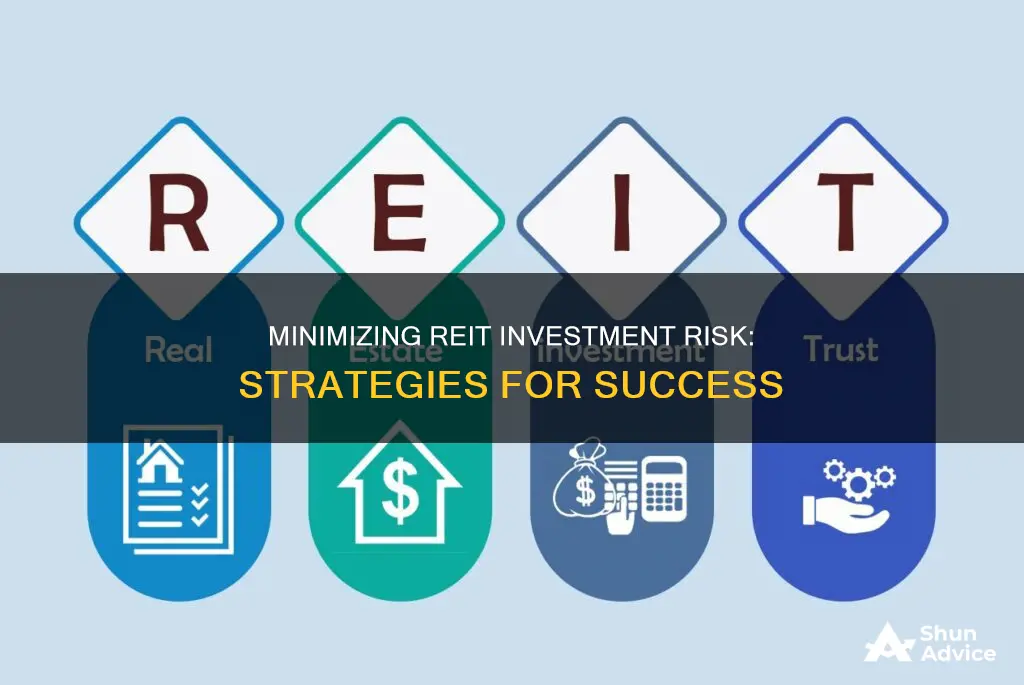
Real estate investment trusts (REITs) are a popular investment vehicle that provides investors with exposure to the real estate market without the complexities of direct property ownership. While REITs offer a range of benefits, including steady income and diversification, they also come with certain risks that investors should be aware of. Understanding these risks is crucial for making informed investment decisions and minimizing potential losses. This article will discuss the different types of risks associated with REITs and provide insights into strategies for reducing these risks.
| Characteristics | Values |
|---|---|
| Share Value | Non-traded REITs are not publicly traded, making it difficult to determine their value. |
| Liquidity | Non-traded REITs are illiquid, and there may be no buyers or sellers when an investor wants to transact. |
| Distributions | Pooled money in non-traded REITs may be paid out as dividends from other investors' money rather than property income, reducing cash flow and share value. |
| Fees | REITs charge an upfront fee of 8-10%, and sometimes up to 15%. They may also incur external manager fees, reducing investor returns. |
| Interest Rates | Rising interest rates may reduce demand for REITs as investors opt for other vehicles like U.S. Treasuries. |
| Sector Choice | Choosing the wrong sector (e.g., suburban malls) may be risky due to online shopping and changing preferences. |
| Taxes | REIT dividends are taxed as ordinary income, so investors must consider their tax bracket and potential tax bill. |
| Diversification | REITs are sensitive to interest rates and may perform poorly if concentrated in a specific sector. They are best included in a diversified portfolio. |
| Fraud | Investors should choose registered REITs to avoid scams. |
What You'll Learn

Understand the risks of non-traded REITs
Understanding the risks associated with non-traded REITs is crucial for making informed investment decisions. Here are some key risks to consider:
Lack of Liquidity
Non-traded REITs are illiquid investments, meaning they cannot be easily bought or sold on the market. Investors might need to wait for an extended period, often more than ten years, for the REIT to list its shares on an exchange or liquidate its assets to achieve liquidity. Early redemption programs offered by some non-traded REITs may come with significant limitations and can be discontinued without notice. Additionally, investors may need to redeem their shares at a discount, resulting in a partial loss of their investment. Therefore, non-traded REITs may not be suitable for those with short investment horizons or immediate liquidity needs.
High Fees
Non-traded REITs typically charge substantial upfront fees, which can range from 9% to 15% of the offering price. These fees compensate intermediaries and reduce the value and return on investment. Additionally, non-traded REITs may have external management fees and other significant transaction costs, such as property acquisition and asset management fees. These fees can impact investor returns, so transparency and careful evaluation are essential.
Distributions and Cash Flow
Non-traded REITs pool investor money to purchase and manage properties. However, distributions may be paid out as dividends from another investor's money rather than income generated by the properties. This practice can limit the REIT's cash flow and diminish the value of its shares. Investors should consider the total return, including capital appreciation and distributions, rather than focusing solely on high distributions, as they may not accurately reflect the REIT's operational earnings.
Lack of Share Value Transparency
Since non-traded REITs are not publicly traded, there is no readily available market price for their shares. This lack of transparency makes it challenging to determine the REIT's share value or investment performance accurately. Share valuations are typically based on periodic or annual appraisals of the REIT's properties, which may not always be accurate or timely. As a result, investors may not have a clear understanding of their investment's value or performance for extended periods.
Conflicts of Interest
Non-traded REITs are often externally managed, and the interests of the external manager may not always align with those of the shareholders. The REIT may pay significant transaction fees for services that benefit the manager more than the shareholders. Additionally, the external manager may be affiliated with competing companies or charge property management or leasing fees, creating potential conflicts of interest.
Petroleum Investment Guide for Indians: Where to Begin?
You may want to see also

Be aware of the impact of rising interest rates
Interest rates and expectations of future changes in monetary policy have impacted the share prices of equity REITs. When interest rates rise, investors tend to move their money to other assets. A rise in interest rates may reduce demand for REITs as investors may choose alternative investments such as U.S. Treasuries, which are government-guaranteed and pay a fixed interest rate.
However, rising interest rates are often driven by economic growth, which may support the growth of REIT earnings and dividends in the future. A growing economy increases the value of REITs because the value of their underlying real estate assets increases. In a growing economy, the demand for financing also increases, resulting in increased interest rates. Conversely, in a slowing economy, when money is tight, the relationship turns negative.
Research shows that REIT returns have generally been positive and have often outperformed the S&P 500 in periods of rising interest rates. Over longer periods, there has generally been a positive association between periods of rising rates and REIT returns. This is because rising rates generally reflect an improvement in the underlying fundamentals. Market interest rates typically increase during periods when macroeconomic conditions are strengthening, which often drives positive REIT investment performance.
Strengthening macroeconomic conditions typically lead to higher occupancy rates, stronger rent growth, increased funds from operations (FFO) and net operating income (NOI), rising property values, and higher dividend payments to investors.
Meeder Investment Management: Is It a Reliable RIA?
You may want to see also

Diversify your REIT portfolio
Diversifying your REIT portfolio is a great way to reduce risk and increase long-term returns. Here are some tips to help you diversify your REIT investments effectively:
- Understand the Different Types of REITs: Familiarize yourself with the three main types of REITs: equity REITs, mortgage REITs, and hybrid REITs. Equity REITs focus on owning and operating properties, while mortgage REITs lend money to property owners or invest in mortgage-backed securities. Hybrid REITs combine these strategies. Each type comes with its own set of risks and potential rewards, so it's important to understand them before investing.
- Spread Your Investments Across Sectors: Diversify your portfolio by investing in REITs from different real estate sectors. Consider residential, commercial, healthcare, retail, and industrial properties. By spreading your investments across sectors, you can balance your portfolio and reduce the impact of any single sector's performance.
- Consider REIT Funds or ETFs: Investing in REIT mutual funds or exchange-traded funds (ETFs) can provide instant diversification with lower individual company risk. These funds hold a variety of REITs, giving you exposure to multiple properties and sectors in a single investment. They are also professionally managed, so you can benefit from expert knowledge.
- Allocate a Suitable Percentage to REITs: There is no one-size-fits-all answer to how much of your portfolio should be allocated to REITs. It depends on your personal circumstances and risk tolerance. A common guideline is to invest your age as a percentage in bonds and the rest in stocks, then allocate a portion of your stock allocation to REITs. Alternatively, you can use more sophisticated asset allocation strategies that take into account expected returns, standard deviations, and correlations of each asset class.
- Research and Select Individual REITs Carefully: When choosing individual REITs, consider your investment goals and risk tolerance. Look into the REIT's portfolio, management team, debt levels, and dividend history. Compare these factors with your investment objectives and your own risk profile.
- Monitor and Evaluate Your REITs Regularly: Once you've invested in REITs, stay informed about their performance, dividends, and valuation. Keep track of their financial statements, earnings reports, and news releases. Compare their performance with peers and benchmarks, and assess your portfolio's risk and return profile. This will help you identify any adjustments needed to maintain your desired allocation and diversification.
By following these strategies, you can effectively diversify your REIT portfolio, reducing risk and improving the potential for long-term returns.
Investment Portfolio Strategies for a Comfortable Retirement
You may want to see also

Research and evaluate the REIT before investing
Researching and evaluating a REIT before investing is crucial to making an informed decision. Here are some detailed instructions on how to approach this process:
Understanding the Basics of REITs
Before investing in a REIT, it's important to grasp the fundamentals of what they are and how they work. REIT stands for Real Estate Investment Trust. These are companies that own, operate, or finance income-producing real estate. By investing in a REIT, you can gain exposure to the real estate market without directly buying, managing, or financing properties.
Examining the Different Types of REITs
There are primarily three types of REITs: Equity REITs, Mortgage REITs, and Hybrid REITs. Equity REITs are the most common and focus on owning and managing income-producing real estate. Mortgage REITs lend money to real estate owners and operators or invest in mortgage-backed securities. Hybrid REITs combine strategies from both equity and mortgage REITs, but they have become less common after the 2007-2008 financial crisis.
Analysing Financial Metrics
When evaluating a REIT, it's essential to look beyond traditional metrics like earnings per share (EPS) and price-to-earnings (P/E) ratio. Instead, focus on funds from operations (FFO) and adjusted funds from operations (AFFO), which provide a more accurate picture by accounting for depreciation and required dividend distributions.
Conducting Top-Down and Bottom-Up Analyses
Consider both macro and microeconomic factors when assessing a REIT. Top-down analysis involves looking at factors such as population and job growth, interest rates, and capital market conditions, which can impact the supply of and demand for property. Bottom-up analysis focuses on the fundamentals of the REIT, including rental income, funds from operations, and the unique strategies employed to improve occupancy and rental rates.
Evaluating Growth Prospects and Acquisitions
Look for REITs with strong growth prospects, such as those that can increase revenue through rental income and related service income. Assess their acquisition strategies and whether they aim to realise economies of scale by assimilating inefficiently run properties. Be cautious of REITs that may be forced into ill-considered acquisitions due to an inability to improve occupancy rates or raise rents.
Analysing Debt and Interest Rate Exposure
Since REITs often deal with significant capital expenditures, it's important to evaluate their debt levels. Compare their debt-to-equity ratios to industry averages or competitors within the same sector. Additionally, consider their mix of fixed-rate versus floating-rate debt, as this can impact their financial performance in different interest rate environments.
Considering Tax Implications
REIT dividends are typically taxed as ordinary income, which can result in higher tax bills, especially for investors in higher tax brackets. Therefore, it's recommended to hold REITs in tax-advantaged accounts, such as Individual Retirement Accounts (IRAs) or 401(k) plans, to mitigate these tax implications.
Starting with Publicly Traded REITs
If you're new to REIT investing, it's generally advisable to start with publicly traded REITs, as they offer greater transparency and are more accessible. Private REITs, on the other hand, are only available to accredited investors and have higher minimum investment requirements.
Doing Your Homework
Before investing, thoroughly research the REIT's portfolio, management team, debt levels, and dividend history. Assess the long-term prospects, examine the fees, and be cautious of potential fraud by ensuring the REIT is registered with relevant regulatory bodies.
Gradually Scaling Your Investment
Start with a modest allocation and gradually increase your exposure to REITs over time. This allows you to get familiar with the real estate market and understand how it correlates with other assets in your portfolio. A well-diversified portfolio might include a 5% to 15% allocation to real estate, depending on your financial goals, risk tolerance, and investment timeline.
Understanding Your Total Investment Portfolio
You may want to see also

Consider tax implications
REIT dividends can be taxed at different rates because they can be allocated to ordinary income, capital gains, and return of capital. The majority of REIT dividends are taxed as ordinary income up to a maximum rate of 37% (returning to 39.6% in 2026), plus a separate 3.8% surtax on investment income. This means that the ordinary income tax rate is the same as the investor's income tax rate, which is likely higher than dividend tax rates or capital gains taxes for stocks.
However, REIT dividends will qualify for a lower tax rate in the following instances:
- When the individual taxpayer is subject to a lower scheduled income tax rate.
- When a REIT makes a capital gains distribution (20% maximum tax rate, plus the 3.8% surtax) or a return of capital distribution.
- When a REIT distributes dividends received from a taxable REIT subsidiary or other corporation (20% maximum tax rate, plus the 3.8% surtax).
- When permitted, a REIT pays corporate taxes and retains earnings (20% maximum tax rate, plus the 3.8% surtax).
The maximum 20% capital gains rate (plus the 3.8% surtax) applies generally to the sale of REIT stock. It's important to note that REIT dividends are considered taxable income in the eyes of the IRS.
To minimize tax implications, many hold REITs in tax-advantaged individual retirement accounts (IRAs) or 401(k)s to mitigate these tax impacts. This way, REIT dividends can compound tax-free (e.g., in Roth accounts) or be tax-deferred (traditional IRAs). This strategy can significantly improve your long-term returns by allowing you to reinvest more of your dividends.
Additionally, the Tax Cuts and Jobs Act of 2017 introduced a qualified business income (QBI) deduction with specific benefits for those holding REITs. The deduction is the QBI plus 20% of qualified REIT dividends or 20% of the taxable income minus net capital gains, whichever is less. This deduction allows eligible taxpayers to deduct up to 20% of their qualified REIT dividends, potentially lowering their effective tax rate on REIT income.
The combination of the QBI deduction, the REIT's tax-advantaged design, and the taxing of dividends creates a complex but potentially beneficial tax situation for many REIT investors. However, balancing this approach as part of your overall investment strategy and liquidity needs is crucial, especially since retirement account funds have withdrawal restrictions.
Risk-laden Investment Strategies: What's the Most Dangerous?
You may want to see also







